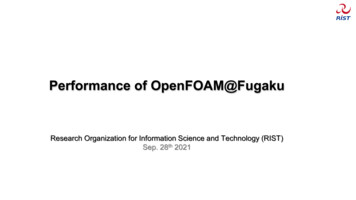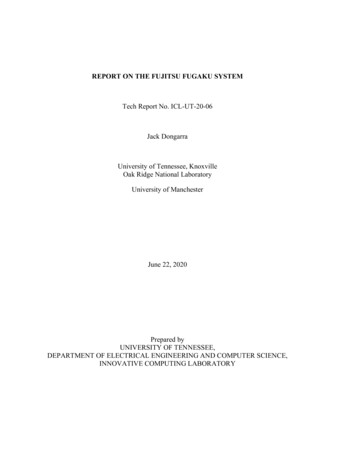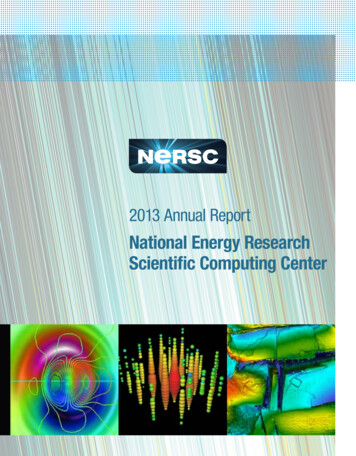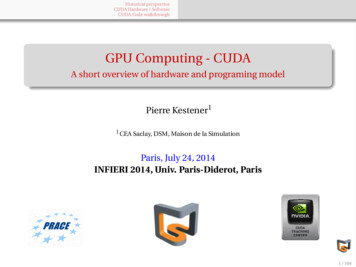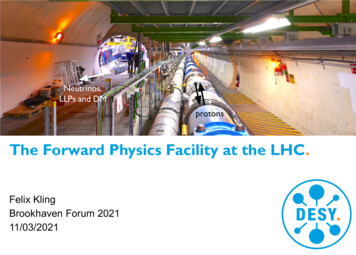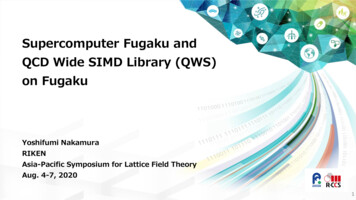
Transcription
Supercomputer Fugaku andQCD Wide SIMD Library (QWS)on FugakuYoshifumi NakamuraRIKENAsia-Pacific Symposium for Lattice Field TheoryAug. 4-7, 20201
Disclaimer The results obtained on the evaluation environment in the trial phase do notguarantee the performance, power and other attributes of the supercomputerFugaku at the start of its operation.2
Outline Supercomputer Fugaku QCD Wide SIMD Library (QWS) Tuning for Fugaku Benchmark on Fugaku Summary and outlooksAcknowledgementsThis talk is based on discussion at 2020 with the LQCD codesign team in flagship 2020 projectRIKEN) Y.N., I. Kanamori, K. Nitadori, M. TsujiFujitsu) I. Miyoshi, Y. Mukai, T. NishikiHiroshima) K.-I. IshikawaKEK) H. Matsufuru3
Supercomputer Fugaku 158,976 nodes (A64FX) 432 racks 396 full nodes (384 nodes) racks 36 half nodes (192 nodes) racksPerformance Normal mode (2.0 GHz) Boost mode (2.2 GHz) DP(64bit) 488 PFLOPS, SP(32bit) 977 PFLOPS, HP(16bit) 1.95 EFLOPS, Int(8bit)3.90 EOPSDP(64bit) 537 PFLOPS, SP(32bit) 1.07 EFLOPS, HP(16bit) 2.15 EFLOPS, Int(8bit)4.30 EOPSMemory : 4.85 PiB, 163 PB/s4
A64FXArchitectureArmv8.2-A SVE (512 bit SIMD)Fujitsu extension : hardware barrier, sector cache, prefetchCore48 ( 2 assistant cores)4 core memory group (4 CMG)TFLOPS2.0 GHz) DP: 3.072, SP: 6.144, HP: 12.2882.2 GHz) DP: 3.3792, SP: 6.7584, HP: 13.5168L1 cache(a 2GHz)L1D/core: 64 KiB, 4way, 256 GB/s (load), 128 GB/s (store)L2 cache(at 2GHz)L2/CMG: 8 MiB, 16wayL2/node: 4 TB/s (load), 2 TB/s (store)L2/core: 128 GB/s (load), 64 GB/s (store)MemoryHBM2 32 GiB, 1024 GB/sInterconnectTofu Interconnect D (28 Gbps x 2 lane x 10 port)6 Tofu network interface (RDMA engine)40.8 GB/s (6.8 GB/s x 6)I/OPCIe Gen3 x16Technology7nm FinFETArchitecture Informationhttps://github.com/fujitsu/A64FX5
QCD Wide SIMD Library (QWS) Lattice quantum chromodynamics simulation library for Fugaku and computers with wide SIMD, in C and C Development Has been started by Y.N. since 2014 for a benchmark program for “Post-K” supercomputer in Flagship 2020 project Y. Mukai (Fujitsu) joined at 2015 K.-I. Ishikawa (Hiroshima) joined at 2015 I. Kanamori (Hiroshima - RIKEN) joined at 2018 High performance on Fugaku (Post-K) Download https://github.com/RIKEN-LQCD/qws (BSD License)Should be used from other QCD applications to get high performance on Fugaku LDDHMC (K.-I. Ishikawa (Hiroshima), used on K) Grid (P. Boyle (Brookhaven), et al. ) Bridge (H. Matsufuru (KEK), et al.) BQCD (H. Stüben (Hamburg), T. Haar, Y.N.)6
Tuning for Fugaku SIMD vectorization for 512 bits SIMD Changing data layout and tuning with Arm C Language Extensions (ACLE) for stencilcalculation (next page) Removing temporal arrays (unnecessary copy) Prefetching explicitly 256 Bytes for all arrays by hands OMP Parallel region expansion : Making omp parallel region is costly, must put“omp parallel” on higher level caller routines (important on many corearchitecture) Avoiding narrow memory bandwidth Increasing reuse of data in low level cache by loop blocking Possible precision changes : double - single, single - half Block Krylov subspace methodMinimizing communication overhead Process mapping and double buffering (Next talk by I. Kanamori)7
Data layout and tuning with ACLE for stencil calculation Continuous access except for x-direction (for example) Fugaku(FP64):[nt][nz][ny][nx/8][3][4][2][8] Fugaku(FP32):[nt][nz][ny][nx/16][3][4][2][16] Fugaku(FP16):[nt][nz][ny][nx/32][3][4][2][32] cf. K:[nt][nz][ny][nx][3][4][2] Tuning with for stencil calculation Useful for general stencil calculation to obtain high SIMD vectorization ratio8
LQCD benchmark test with QWS on Fugaku Target problem is 1924 using full system of Fugaku Nodes : 147456 MPI processes : 589824 (4 proc / node) OMP threads : 12 / proc Local lattice size : 32x6x4x3 / procSingle precision BiCGstab solver (Dx b) Evaluation region in FS2020 project Clover Wilson Dirac operator (D) 5 iteration Schwarz Alternating Procedure (SAP) preconditioning 2 iteration Jacobi solver for inside domain Dirac operator9
1 node performance (single precision, 2.2GHz) Performance (TFLOPS, single peak ratio) 4 proc/node 2 domains/proc of domain decomposition Size / procDinBiCGStab32x6x4x3 (target size)1.15 TFLOPS, 17%0.88 TFLOPS, 13%32x6x4x61.35 TFLOPS, 20%1.16 TFLOPS, 17%32x6x8x61.51 TFLOPS, 22%1.05 TFLOPS, 16%32x6x8x121.20 TFLOPS, 18%0.93 TFLOPS, 14%32x12x8x121.14 TFLOPS, 17%0.85 TFLOPS, 13%On L2 Din bulk Clover-Dirac operator multiplication No nearest neighbor communication10
Target problem weak scaling (before mid-July 2020)Full nodeMatvecLinear algebraSpeedup factor from Kwith same conditions full system use problem size algorithmAllreduce(2elem)Linear algebraAllreduce(1elem)MatvecBiCGStab1 iterLinear algebraAllreduce(3elem)Linear algebraAllreduce(3elem)Ideal case of less OS jitterLinear algebra11
Target problem weak scaling (after mid-July 2020, under the noise reduction environment)Full nodeMatvecLinear algebraSpeedup factor from Kwith same conditions full system use problem size algorithmAllreduce(2elem)Linear algebraAllreduce(1elem)Matvec 110PFLOPSBiCGStab1 iterLinear algebraAllreduce(3elem)Linear algebraAllreduce(3elem)Ideal case of less OS jitterMaximum nodes(147456 nodes)for 192 4Linear algebra12
Summary and outlooks Supercomputer Fugaku Installation was completed Tuning system softwareQWS Publicly available Confirming performance on FugakuLQCD Benchmark results on 1924 35 times faster than the K computer 100 PFLOPS single precision BiCGStabPlan Testing with McKernel (Light-Weight Kernel, No OS jitter)13
6 Lattice quantum chromodynamics simulation library for Fugakuand computers with wide SIMD, in C and C Development Has been started by Y.N. since 2014 for a benchmark program for "Post-K" supercomputer in Flagship 2020 project Y. Mukai (Fujitsu) joined at 2015 K.- I. Ishikawa (Hiroshima) joined at 2015 I. Kanamori (Hiroshima - RIKEN) joined at 2018


